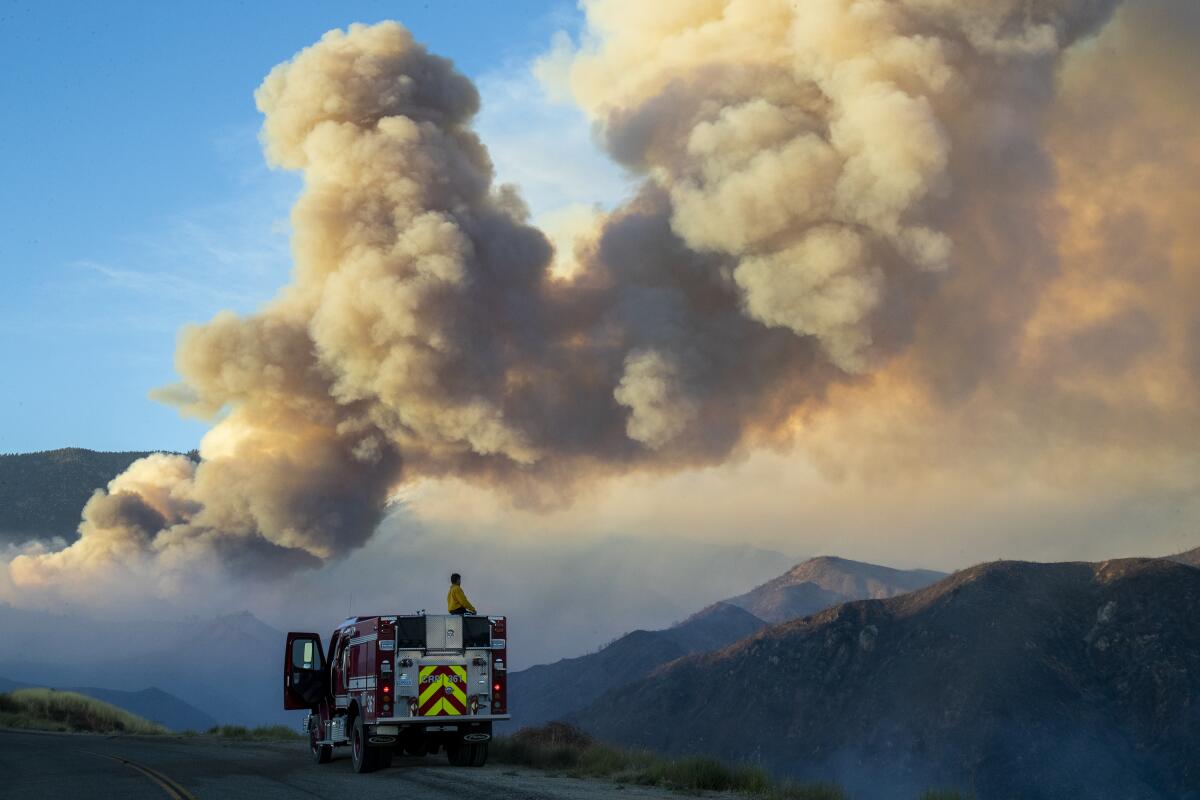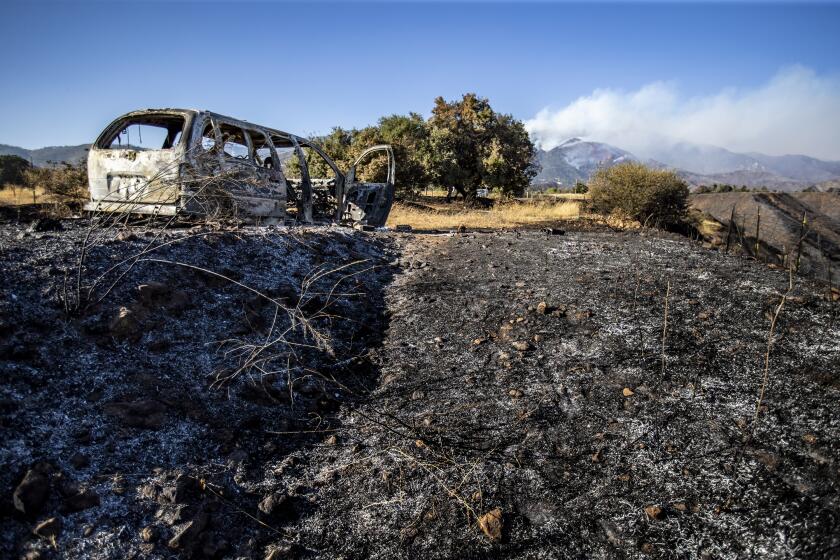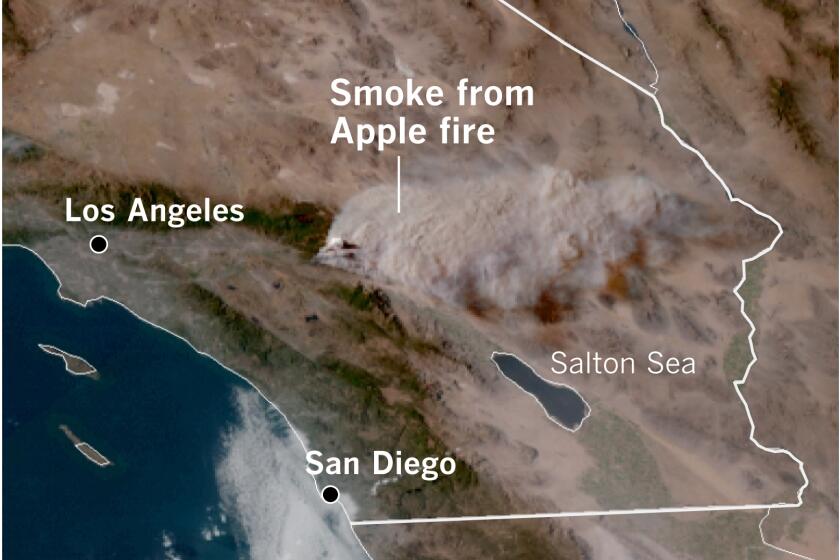Firefighters struggle to control Apple fire in Riverside County as winds pick up

- Share via
California’s first major wildfire of the year grew to more than 20,000 acres over the weekend, destroying one home, forcing thousands to evacuate and sending up a plume of smoke so massive that it generated its own winds, authorities said.
The Apple fire in Riverside County burned up steep and rugged hillsides, making it inaccessible to firefighting vehicles as it spread north and east toward the San Gorgonio Wilderness while continuing to threaten homes to the south.
The fire spread rapidly in the early hours of Sunday, growing to 20,516 acres — or 32 square miles — by mid-morning. The blaze was 5% contained as of 7 p.m. as 2,200 fire personnel in the air and on the ground worked to douse it.
Officials were unable to gauge the exact size of the blaze Sunday evening, but Lisa Cox, fire information officer for the San Bernardino National Forest, said that “there was significant growth and fire activity.”
Multiple evacuation orders and warnings remained in place Sunday in both Riverside and San Bernardino counties. Roughly 7,800 residents in over 2,500 households were ordered to evacuate, according to April Newman, a public information officer with the California Department of Forestry and Fire Protection and the Riverside County Fire Department.
The terrain is characterized by a web of narrow canyons and drainage channels, which has created the potential for extremely active fire behavior, Cox said.
The blaze had burned 26,450 acres and was 5% contained as of Monday morning.
“What we saw yesterday was a perfect example of that,” she said, referring to a large pyrocumulus cloud that mushroomed up from the fire and into the sky on Saturday. The towering spectacle, which creates its own turbulent weather, could be seen all the way in Los Angeles.
The cloud pushes embers down and blows them in all directions, creating the potential for rapid and unpredictable spread, Cox said. “The concern with that is that firefighters cannot control what that plume of smoke does,” she said.
On Sunday, humidity levels plummeted to the teens by mid-afternoon. Westerly winds picked up after 3 p.m. and peaked between 6 and 9 p.m. at 10 to 20 mph, with gusts of up to 30 mph, said Miguel Miller, a meteorologist with the National Weather Service in San Diego. The pattern of winds strengthening in the late afternoons and evenings will likely persist for the next several days, he said.
“It’s not anything outrageous or very strong, but it’s enough to push the fire around a little bit,” he said.
An evacuation center for people and animals was opened at Beaumont High School, where the American Red Cross arranged hotel rooms for 32 people from about 10 households Saturday night, regional disaster officer Debbie Leahy said Sunday.
The evacuation center is staffed by volunteers who are trained in COVID-19 safety protocols and outfitted with face coverings, and social distancing is strictly observed, she said. All who enter must undergo a brief health screening, and nurses are also conducting daily telephone screenings of the evacuees who were placed in hotel rooms, she said.
“We’re in a COVID environment, and then if we have these wildfires at that, it complicates the situation,” she said. “But if we just all focus on safety, we’re going to be OK.”
Gov. Gavin Newsom announced Sunday that California has secured a grant from the Federal Emergency Management Agency to help ensure the availability of resources to fight the Apple fire. The grant will also assist local and state agencies responding to the fire to apply for reimbursements for up to 75% of fire suppression costs.
The U.S. Forest Service on Saturday ordered an emergency closure of the San Gorgonio Wilderness, including the Pacific Crest Trail between the forest boundary and Forest Road 1N01. Forest Service recreation areas in the Forest Falls area were also closed.
Forest Service recreation staff and volunteers visited trailheads to let hikers and backpackers know that the wilderness area is closed, and on Saturday announcements were also made via helicopter, Cox said.
“They’re not in danger right at this moment, but we preemptively want to make sure they have enough time to get out,” she said.
The vegetation fire was first reported at 4:55 p.m. Friday in the 9000 block of Oak Glen Road, according to the Riverside County Fire Department. There wasn’t word on its cause.
The fire was burning through thick grasses and brush, which were fueled by seasonal rainfall that was close to average in the area, Miller said.
“That made for a decent green-up, as they call it, in the springtime — leafing out the vegetation, the grasses get going,” he said. “Then by May, June, certainly by July ... those grasses simply dry up, they turn yellow, they turn flammable. And that’s why summertime is the high fire season.”
Another brush fire erupted in Southern California on Sunday night in Gorman, an unincorporated community in northwestern L.A. County. The blaze had grown to 200 acres, and forward progress had been stopped by 9 p.m., according to the L.A. County Fire Department. The fire ignited near Gorman Post Road and northbound Interstate 5 two hours earlier.
More to Read
Sign up for Essential California
The most important California stories and recommendations in your inbox every morning.
You may occasionally receive promotional content from the Los Angeles Times.














